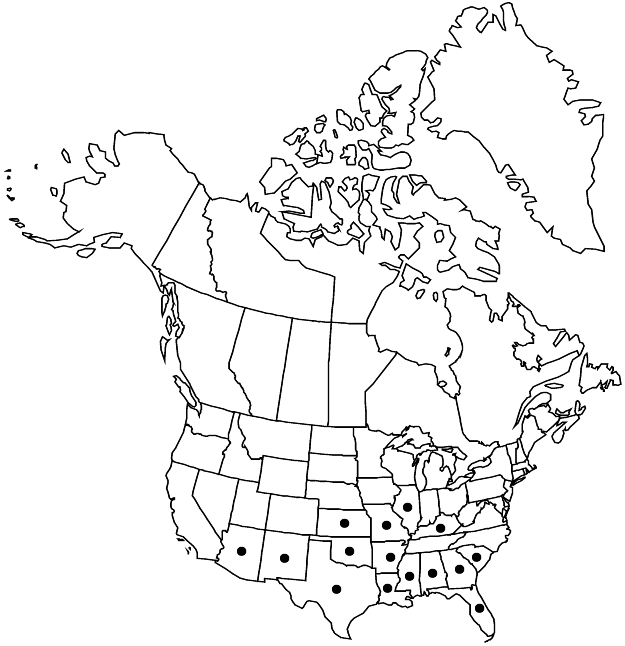Sideroxylon lanuginosum
Fl. Bor.-Amer. 1: 122. 1803 ,.
Shrubs or trees, to 15 m. Stems not armed or armed, villous, glabrescent. Leaves deciduous; petiole 2–14 mm, villous or sparsely hairy to glabrate; blade (dull to lustrous adaxially), oblong or oblanceolate to spatulate, 15–97 × 7–40 mm, base acute to attenuate, margins plane, apex rounded to obtuse, rarely acute, abaxial surface usually villous, rarely glabrate, venation visible, midrib villous (hairs white or gray to tawny, entangled, wavy), adaxial surface glabrate (hairs scattered along midribs), midrib flat, marginal vein absent. Inflorescences 7–17-flowered. Pedicels 2–7 mm, villous, rarely glabrous. Flowers: calyx 1.9–3.2 mm diam.; sepals (4–)5, 1.8–2.8 × 1.4–1.9 mm, lanate-villous; petals (4–)5(–6), white, median segment oblong to ovate, 1.2–1.8 mm, lateral segments lanceolate or falcate, 0.8–1.8 mm; stamens 5(–6), 2.5–2.8 mm; staminodes lanceolate, 1.3–2.5 mm, entire or erose; anthers sagittate, 0.8–1.2 mm; pistil 5(–8)-carpellate; ovary 5(–8)-locular, 1–1.2 mm, strigose; style 1.1–1.5 mm. Berries purplish black, broadly ellipsoid to obovoid, 7–12 mm, glabrate. Seeds 6–11 mm.
Distribution

Ala., Ariz., Ark., Fla., Ga., Ill., Kans., Ky., La., Miss., Mo., N.Mex., Okla., S.C., Tex., n Mexico.
Discussion
Subspecies 3 (3 in the flora).
Sideroxylon lanuginosum is the most widespread and morphologically variable North American species of the genus. Segregate species, subspecies, and varieties have been recognized based on variation in thorn presence, leaf size, abaxial leaf indument, and color of the leaf hairs. Based on our observations and those of A. Cronquist (1945c) and T. D. Pennington (1990), morphological variants are generally consistent within regions. Most recent authors have recognized three to five subspecies and/or varieties in S. lanuginosum (e.g., D. S. Correll and M. C. Johnston 1970; J. T. Kartesz and K. N. Gandhi 1990; B. L. Turner et al. 2003).
We recognize three subspecies without varieties based on differences in leaf size and hair color on the abaxial leaf surfaces. A. Cronquist (1949) and T. D. Pennington (1990) also recognized three subspecies; Cronquist further divided subsp. oblongifolium by hair color (variants with white hairs = var. albicans) and the smaller-leaved subsp. rigidum by density of indument (less hairy variants = var. texanum). Discriminating among leaf surface hair densities and the white to gray hair color continuum is particularly difficult in areas of parapatry and sympatry among subspecies in Oklahoma, Texas, and northern Mexico. We present a conservative treatment and encourage detailed studies of morphological and molecular variation throughout the range of the S. lanuginosum complex.
Selected References
None.
Lower Taxa
Key
| 1 | Leaf blades 15-50 mm. | Sideroxylon lanuginosum subsp. rigidum |
| 1 | Leaf blades 52-97 mm | > 2 |
| 2 | Abaxial leaf hairs tawny. | Sideroxylon lanuginosum subsp. lanuginosum |
| 2 | Abaxial leaf hairs white to gray. | Sideroxylon lanuginosum subsp. oblongifolium |